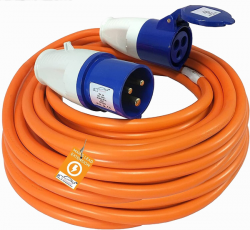Mains Hook Up - EHU

Mains Hookup
If you're using an extension cord to provide power to your motorhome, it's generally a good practice to fully unwind the cord before use. Coiled or partially wound extension cords can generate heat and potentially become a fire hazard due to the restricted airflow. Fully unwinding the cord helps to dissipate any heat that might be generated during use and reduces the risk of overheating.
Additionally, make sure you're using an extension cord that's appropriate for the power requirements of your motorhome and the devices you're connecting to it. Using an extension cord with a lower amperage rating than needed can also lead to overheating and pose a safety risk.
The standard is typically 25 meters. However, if you anticipate visiting international sites beyond the UK, having a 50-meter extension could prove to be beneficial.
Using a joiner with extension leads to supply your motorhome with electrical power can be done, but it's important to do so safely and responsibly. Here are some considerations:
Compatibility: Ensure that the joiner you use is compatible with the extension leads you're connecting. The joiner should be rated for the same or higher amperage as the extension leads to avoid overheating and potential hazards.
Amperage Rating: Make sure that the combined amperage of your motorhome's electrical load and the extension leads falls within the capacity of the joiner. Using a joiner with a lower amperage rating than needed can lead to overheating and safety risks.
Quality: Use high-quality, well-insulated joiners that are designed for outdoor or heavy-duty use if you're using them to connect extension leads for your motorhome. Cheap or poorly-made joiners might not provide a secure and reliable connection.
Voltage Drop: Keep in mind that using long extension leads or multiple joiners can result in voltage drop, which can affect the performance of your motorhome's appliances and devices. If possible, minimize the length of the extension leads and the number of joiners used to reduce voltage drop.
Weather Protection: If you're using the extension leads and joiners outdoors, ensure that they are rated for outdoor use and are properly protected against moisture and weather conditions.
Inspection: Regularly inspect the joiners, extension leads, and connections for signs of wear, damage, or deterioration. Replace any components that appear damaged or compromised.
Site Approval: Some sites may condemn the use of joiners considering them a fire risk.
-
Battery Maintenance: Keeping your motorhome plugged in can help maintain the charge of your batteries, especially if it has a built-in battery charging system. This can prevent your batteries from discharging too much, which can extend their lifespan.
-
Readiness: When your motorhome is constantly plugged in, it's ready to use at any time. You don't need to worry about preparing it before a trip by charging batteries or cooling down the interior.
-
Appliance Usage: If you're parked at a location with electrical hookups, you can run your appliances, air conditioning, and other electrical systems without worrying about draining your batteries.
Disadvantages:
-
Overcharging: Leaving your motorhome plugged in for extended periods could potentially overcharge your batteries, which can lead to decreased battery life and performance. Most modern Motorhomes have built-in battery management systems to mitigate this risk, but it's still something to consider.
-
Electrical Costs: Continuous electrical usage can lead to higher electricity bills, especially if you're using appliances like air conditioning frequently.
-
Maintenance Costs: If you're consistently plugged in, it might lead to more wear and tear on certain components of your motorhome's electrical system, potentially requiring more maintenance over time.
-
Fire Risk: While modern Motorhomes are generally designed with safety features, there's always a small risk of electrical issues leading to fires. This risk is generally higher if the electrical system is constantly under load.
-
Environmental Impact: Leaving your motorhome plugged in at all times can have an environmental impact, contributing to energy consumption and potentially increasing your carbon footprint.
To make an informed decision, consider your specific circumstances:
-
Usage: How often do you use your motorhome? If it's frequently used, leaving it plugged in might make more sense.
-
Battery Type: The type of batteries you have (e.g., lead-acid, lithium) and their charging characteristics can influence whether it's advisable to leave them plugged in.
-
Weather: Extreme temperatures can affect battery performance. For example, if you're in an area with very cold winters, it might be better to store your motorhome unplugged to prevent battery damage from freezing.
-
Battery Management: If your motorhome has a sophisticated battery management system that prevents overcharging and adjusts charging levels based on battery health, the risks associated with leaving it plugged in might be minimized.
Yes, when supplying electricity to your motorhome from a site outside the UK, you may need a special adapter to ensure compatibility with the local electrical outlets and voltage standards. Different countries use different types of plugs, voltages, and frequencies for their electrical systems. Here are a few important considerations:
Plug Type:
Different countries use various plug types, so you'll need an adapter that can convert your motorhome's plug to the appropriate type used in the country you're visiting.
Voltage and Frequency:
Voltage and frequency standards can vary between countries. Some countries use 220-240V at 50Hz, while others might use 110-120V at 60Hz. Make sure your motorhome's electrical system is compatible with the local voltage and frequency.
Safety and Certification:
When purchasing adapters, ensure they are certified for safety and quality. Look for adapters that meet relevant international standards to avoid electrical hazards.
Ampere Rating:
Ensure that the adapter you choose can handle the amperage requirements of your motorhome. Using an adapter with a lower amperage rating than needed can lead to overheating and potential risks.
Cable Length and Quality:
Consider the length and quality of the cable on the adapter. A longer cable may provide more flexibility in connecting to the site's power source.
Weather Resistance:
If you plan to use the adapter outdoors, ensure it is designed to be weather-resistant or use it in a protected location.
Research Before Traveling:
Before traveling to a specific country, research their electrical standards and requirements to ensure you have the appropriate adapter(s) and are prepared for the electrical setup at the site.
It's advisable to carry a selection of adapters that cover the plug types and electrical standards commonly found in the countries you plan to visit. This will help you ensure a safe and reliable power supply for your motorhome during your travels.
However it is worth noting that it is becoming more common for sites outside of the UK to use the standard CEE socket
One further consideration is polarity of the circuit. You can get a situation whereby the live and the neutral is reversed on site supplies. This shouldn't cause an issue with most electrical items used in your motorhome, but you can make up converter cables to get over this. Many motorhomes take with then a Polarity Checker, which is a simple plug-in device bought at most DIY stores. However as previously mentioned it is unlikely to do any harm.
PLEASE SEE AT BOTTOM OF PAGE FOR LIST OF SOCKET TYPES
Safety First:
Before attempting any checks, ensure your safety by switching off the main supply and disconnecting from the power source.
Overload Check:
Check if you have connected too many appliances simultaneously, causing an overload. Unplug some devices and try resetting the circuit breaker or RCD.
Faulty Appliance:
If the trip occurred while using a specific appliance, that appliance could be faulty and causing the trip. Disconnect it and test again.
Short Circuit:
Inspect power cords and connections for signs of damage or exposed wires, which might cause a short circuit. Repair or replace as needed.
Weather and Moisture:
Wet conditions can cause trips. Ensure all outdoor connections are properly sealed and protected from moisture.
Electrical System: If the issue persists, it could be a problem within your motorhome's electrical system. Check for any visible signs of damage, loose wires, or burnt components.
GFCI/RCD Test:
If your motorhome is equipped with Ground Fault Circuit Interrupter (GFCI) or Residual Current Device (RCD) outlets, press the "Test" button to check if they're functioning correctly.
External Power Source:
If using a campsite hookup, verify that the power supply itself is stable and not causing the trip.
Circuit Breaker Reset:
If you've identified the cause and resolved it, reset the circuit breaker or RCD. If the issue persists, it might be advisable to seek professional assistance.
Professional Help:
If you can't identify or rectify the problem, it's best to consult a qualified electrician or motorhome technician to ensure your electrical system is safe and properly functioning.
Common Countries Standard Sockets & Current
United States: Type A/B (120V)
- Type A: Two flat parallel pins.
- Type B: Type A with an additional grounding pin.
- 120V voltage for residential use.
United Kingdom: Type G (230V)
- Three rectangular pins in a triangular pattern.
- High voltage of 230V with built-in safety features.
Australia: Type I (230V)
- Three flat pins in a diagonal configuration.
- 230V voltage with grounding for safety.
European Union: Type C/E/F (230V)
- Type C: Two round pins.
- Type E/F: Type C with additional grounding.
- Standardized 230V voltage for most of Europe.
South Africa: Type C/D/M/N (230V)
- Type C: Two round pins.
- Type D: Three large round pins.
- Type M: Three large round pins in a triangular pattern.
- Type N: Type M with an additional grounding pin.
- 230V voltage with various options.
Russia: Type C/F (220V)
- Type C: Two round pins.
- Type F: Type C with additional grounding.
- 220V voltage, commonly used across the country.
New Zealand: Type I (230V)
- Three flat pins in a diagonal configuration.
- 230V voltage with grounding for safety.
France: Type C/E (230V)
- Type C: Two round pins.
- Type E: Type C with an additional grounding pin.
- 230V voltage, common in European countries.
Germany: Type C/F (230V)
- Type C: Two round pins.
- Type F: Type C with additional grounding.
- 230V voltage, common in Europe.
Italy: Type C/F/L (230V)
- Type C: Two round pins.
- Type F: Type C with additional grounding.
- Type L: Three round pins in a row.
- 230V voltage, common in Europe.
Spain: Type C/F (230V)
- Type C: Two round pins.
- Type F: Type C with additional grounding.
- 230V voltage, common in Europe.
These characteristics reflect the variety of plug socket types and voltages found around the world, driven by historical, safety, and regional factors. It's important to consider these differences when traveling or using electrical devices internationally.
Always check for recent changes or if these apply locally

